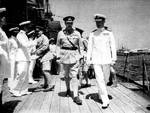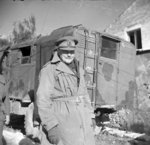Bernard Freyberg
| Surname | Freyberg |
| Given Name | Bernard |
| Born | 21 Mar 1889 |
| Died | 4 Jul 1963 |
| Country | New Zealand, United Kingdom |
| Category | Military-Ground |
| Gender | Male |
Contributor: C. Peter Chen
ww2dbaseBernard Cyril Freyberg was born in Richmond, Surrey, London, England, United Kingdom. He moved to New Zealand with his family at the age of two. Between 1897 and 1904, he attended Wellington College. On 22 May 1911, he became an assistant to a dentist in Morrinsville, and later opened his own practice in Hamilton and in Levin. In Mar 1914, he left New Zealand and traveled to San Francisco, California, United States and then to Mexico; records did not clearly show why he was in North America.
ww2dbaseWhen WW1 began, Freyberg traveled to England to meet with First Lord of the Admiralty Winston Churchill, whom he convinced to grant him a commission in the Hood Battalion of the Royal Naval Division. In 1915, he fought in the Dardanelles campaign and participated in the Gallipoli landings, where he won his first Distinguished Service Order medal. In May 1916, he fought in France and won the Victoria Cross at the Battle of the Somme. On 13 Nov 1916, at Beaucourt-sur-Ancre, France, he led his initially disorganized troops on an assault that turned the tide, capturing 500 Germans after taking a heavily fortified village. In Apr 1917, he was promoted to the war time rank of brigadier and was given command of a brigade in the 58th Division. By the time WW1 ended, he earned another two Distinguished Service Order medals and a French Croix Militaire de Guerre.
ww2dbaseDuring the inter-war years, Freyberg remained in the British Army.
ww2dbaseOn 14 Jun 1922, Freyberg married Barbara McLaren, daughter of Sir Herbert Jekyll at St. Martha on the Hill. Barbara had two children from her previous marriage, and the couple had one son in 1923.
ww2dbaseIn 1937, the British Army classified Freyberg unfit for active service, but as the European War began, he was put on the active list regardless. Because of his New Zealand upbringing, he was assigned the commander of the New Zealand 2nd Expeditionary Force and of the New Zealand 2nd Division. In 1941, he served as the British and Commonwealth troops at Crete, Greece. After the loss at Crete, he continued to command the New Zealand 2nd Division in North Africa, participating in Operation Supercharge at El Alamein and Operation Supercharge II at Tebaga Gap. After North Africa, he led the New Zealand forces in Italy. He gained a reputation as one who was willing to challenge his superiors if he believed any orders were given with prejudice against the New Zealand troops. He was popular among soldiers, New Zealand and otherwise, for his concern for the welfare of his troops. In terms of leadership, he was known to be an able divisional level tactician, but was less so at the corps level, as shown when he commanded corps level forces at Tebaga Gap and Monte Cassino.
ww2dbaseFreyberg retired from military service soon after the European War. Between 1946 and 1952, he was the Governor-General of New Zealand. In 1951, he was made Baron Freyberg of Wellington, New Zealand and of Munstead, Surrey, England. In 1952, he returned to England, and on 1 Mar 1953 he became the Deputy Constable and Lieutenant-Governor of Windsor Castle. He passed away in 1963 following the rupture of one of his war wounds. He was buried at the church of St. Martha on the Hill in Guildford, Surrey.
ww2dbaseSource: Wikipedia.
Last Major Revision: Apr 2008
Photographs
 |  |  |
Bernard Freyberg Timeline
| 21 Mar 1889 | Bernard Freyberg was born. |
| 29 Nov 1940 | General Freyberg's British and New Zealand troops occupied all of Crete. |
| 17 Feb 1941 | The decision to despatch a British Expeditionary Force to Greece was communicated to General Bernard Freyberg VC, General Officer Commanding New Zealand Division. The force initially was planned to consist of the New Zealand Division, 1st British Armoured Brigade, 6th Australian Division, Polish independent Brigade Group and 7th Australian Division. However Erwin Rommel's sudden advance into the Cyrenaica of Libya would result in the Poles and 7th Australian Division being held back to defend Tobruk. |
| 1 May 1941 | General Bernard Freyberg arrived in Crete, Greece where he planned to concentrate his New Zealand Division, supported by 3,500 Greek troops around Maleme to defend the airstrip there. |
| 5 May 1941 | Major General Bernard Freyberg was appointed the commander of British and Commonwealth forces at Crete, Greece. |
| 14 Jun 1941 | In a letter to General Hastings Ismay, Winston Churchill critised Bernard Freyberg's tactical handling of the defence of Crete, Greece, in particular the fact that no counter-attack had been mounted in the western sector (e.g. around Maleme airfield) for 36 hours after the initial German assault. |
| 4 Jul 1963 | Bernard Freyberg passed away. |
Did you enjoy this article or find this article helpful? If so, please consider supporting us on Patreon. Even $1 per month will go a long way! Thank you. Share this article with your friends: Stay updated with WW2DB: |
Visitor Submitted Comments
13 Apr 2015 07:29:57 AM
so intresting
1 Aug 2015 12:05:25 AM
The story that Freyberg, on his way to Europe to volunteer in 1914, had joined Pancho Villa's rebel army in Mexico and 'reached the rank of General' was a preposterous exaggeration which Churchill, who was always impressed by men-of-action, helped to circular. The canard, which gave Freyberg a certain amount of notoriety, lasted until well after the Second World War. 'The truth is', Freyberg said in 1948 when Governor-General of New Zealand, ' I have never bothered to contradict it'.
13 Sep 2015 01:20:26 AM
Freyberg found ill will with some in the British High Command. General Alan Brooke, the Chief of the Imperial General Staff, felt the Kiwi commander to be "casualty conscious", and General Montgomery changed his opinion of Freyberg, believing that he had allowed a defeated Rommel to escape from El Alamein - his best divisional commander, he suggested, was now "a nice old boy but a bit stupid."
3 Jan 2020 05:32:43 PM
When some British officers complained about the lack of saluting from NZ soldiers, Freyberg replied "just give them a wave, and they will wave back"
All visitor submitted comments are opinions of those making the submissions and do not reflect views of WW2DB.
» Balkans Campaign
» Second Battle of El Alamein
» Operations Pugilist and Supercharge II
» Battle of Monte Cassino
- » 1,150 biographies
- » 337 events
- » 43,917 timeline entries
- » 1,241 ships
- » 350 aircraft models
- » 207 vehicle models
- » 374 weapon models
- » 123 historical documents
- » 260 facilities
- » 470 book reviews
- » 28,544 photos
- » 432 maps
Chiang Kaishek, 31 Jul 1937
Please consider supporting us on Patreon. Even $1 a month will go a long way. Thank you!
Or, please support us by purchasing some WW2DB merchandise at TeeSpring, Thank you!
22 Dec 2014 04:05:11 PM
interested in the family background of Bernard Cyril Freyberg before his birth in Richmond, Surrey.